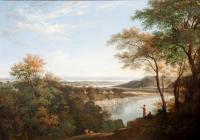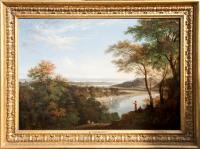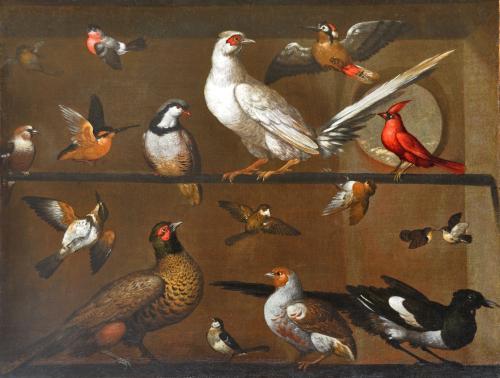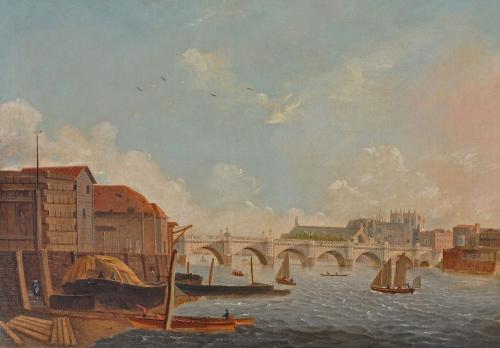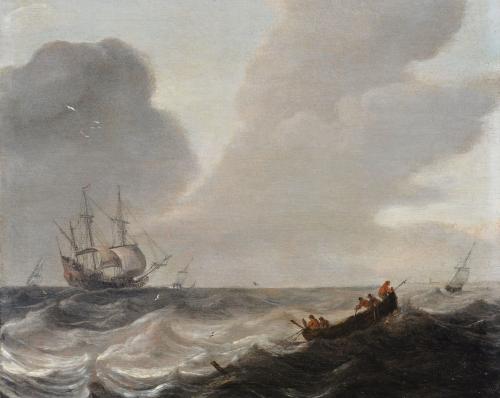
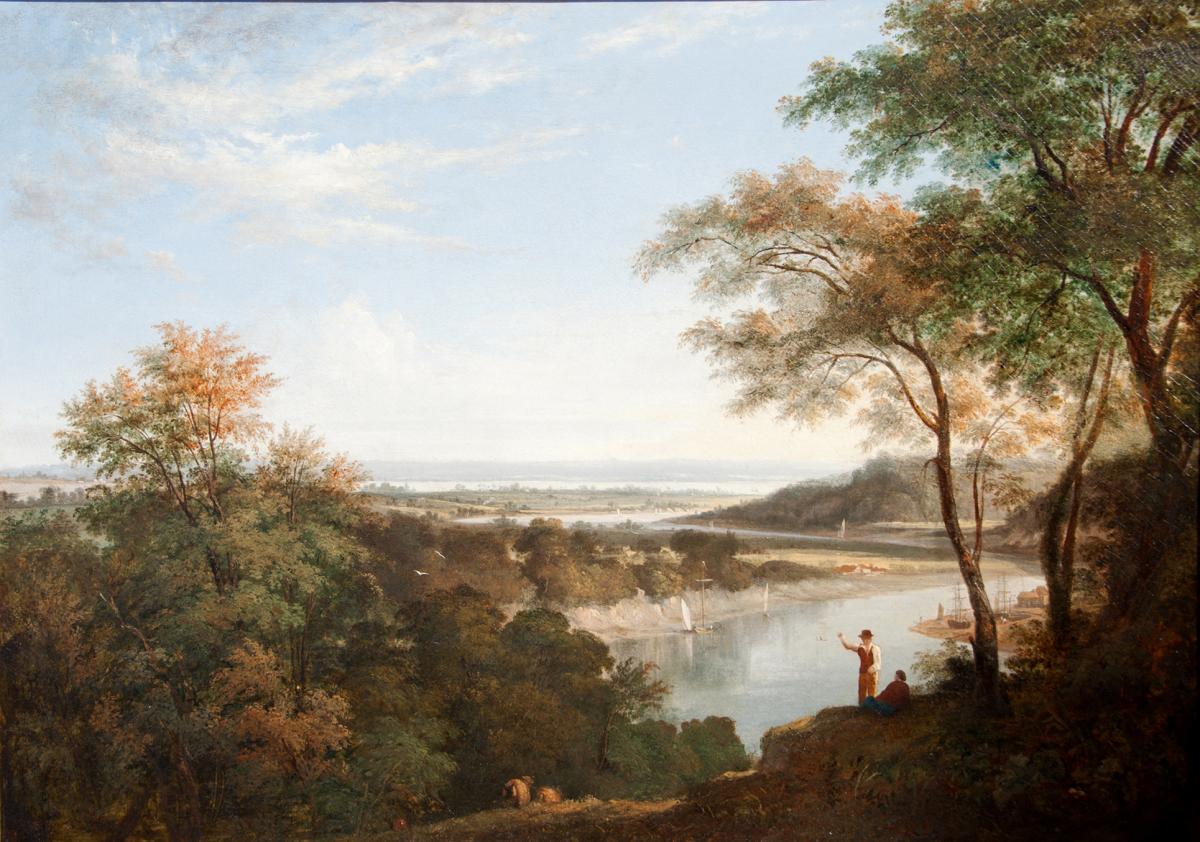
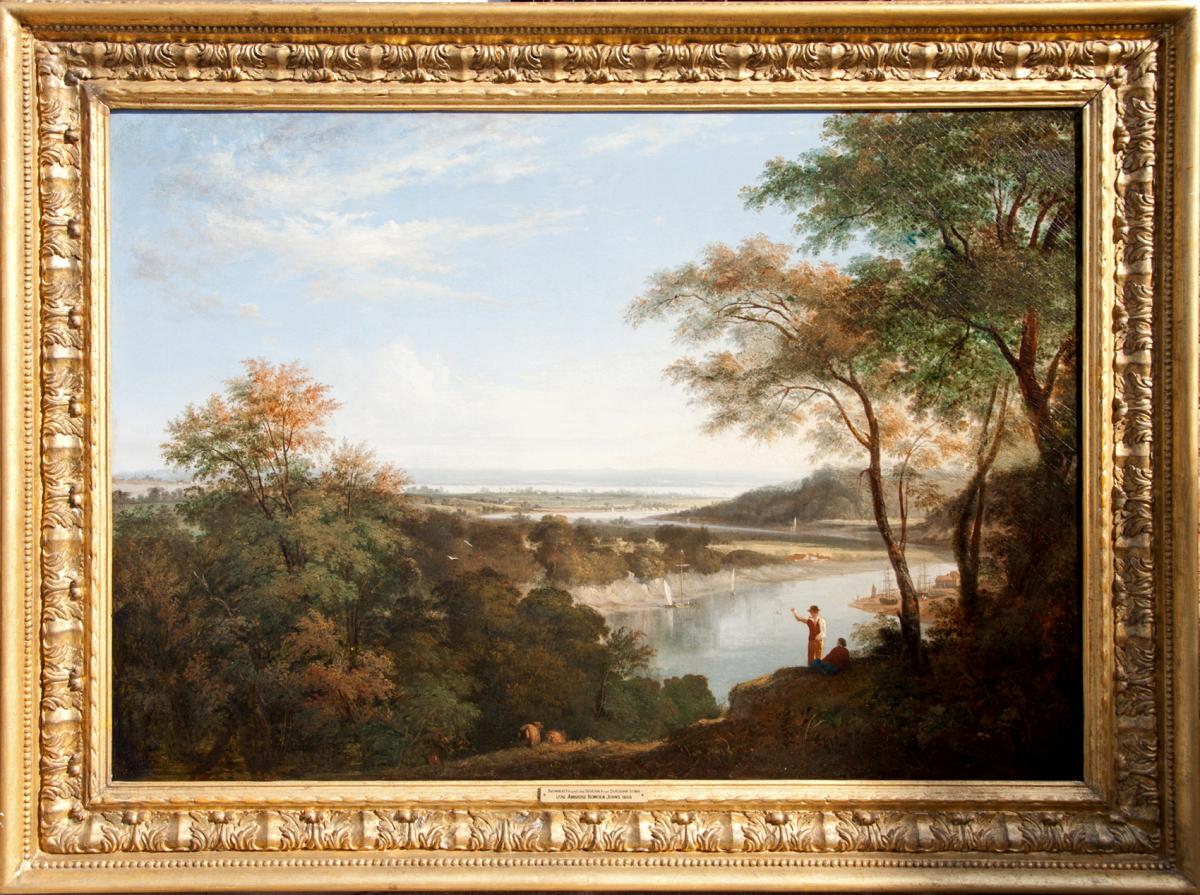
Price on application
This object is eligible for a Certificate of BADA Provenance
The BADA Standard
- Since 1918, BADA has been the leading association for the antiques and fine art trade
- Members are elected for their knowledge, integrity and quality of stock
- Our clients are protected by BADA’s code of conduct
- Our dealers’ membership is reviewed and renewed annually
- Bada.org is a non-profit site: clients deal directly with members and they pay no hidden fees
Ambrose Bowden Johns.
English School.
1776-1858.
Avonmouth and the Severn from Durdham Down.
Oil on canvas.
61 x 49.7 cms.
24 x 19 1/2 inches.
Overall framed size 91.5 x 120.2 cms.
361/16 x 473/8 ins.
Provenance: With Pawsey and Payne, London.
Ambrose Bowden Johns was born in Plymouth in 1776 but little is known of him before he was apprenticed to the well-to-do Wimpole St based printer and publisher Benjamin Haydon. The former had little inclination to have a career in printing, a sentiment shared apparently with Haydon himself who had wanted to join the military but had to go into his father’s business.
Johns had been encouraged by the Plymouth portrait, historical and animal painter James Northcote (1746-1831) to follow his calling and become a landscape painter and his association with Northcote and other local artists such as Sir Charles Lock Eastlake enabled his artistic development. He was also close to his erstwhile employer’s son, Benjamin Robert Haydon (1786-1846) who became a significant painter of large-scale historical and genre paintings.
J M W Turner travelled to the West Country three times between 1811 and 1814 and the Tate holds the six sketchbooks from those trips. It has been suggested that Turner first met Johns in 1811 and the local artist, together with others, played a significant role both artistically and socially in Turner’s time in south Devon. Indeed, Turner stayed with Johns in the cottage that the latter had built himself and they sketched together forming a friendship and artistic bond. Turner, who was even at that time known as “The Great”, was renowned for travelling with insufficient equipment to undertake all the studies that he hoped to accomplish. Eastlake wrote that Johns “…fitted up a small, portable painting box, containing some prepared paper for oil sketches, as well as the other necessary materials. When Turner halted at a scene and seemed inclined to sketch it, Johns produced the inviting box, and the great artist, finding everything ready to his hand, immediately began to work. As he sometimes wanted assistance in the use of the box, the presence of Johns was indispensable… Johns accompanied him always. When Turner left Plymouth he carried off all the results. We had reckoned that Johns, who has provided all the materials, and had waited upon him devotedly, would at least have a present or two of the sketches. This was not the case; but long afterwards the great painter sent Johns in a letter a small oil sketch, not painted from Nature, as a return for his kindness and assistance.”
A B Johns’ paintings depict almost entirely Devon views and in these works one can discern a keen acuity and sympathy for the local environment. His influences are Turner, Richard Wilson, Gaspard Dughet and the great “painter of air” Claude Gellée. The close association with Turner can be seen in Johns’ paintings, so much so that when a painting by Johns, owned by the art critic Samuel Carter Hall, was engraved by J Cousen and then published, it was erroneously ascribed to Turner and despite a printed newspaper apology by the publishers, the painting was subsequently sold by Christie’s as by Turner. That was not the last time that his work was confused with that of Turner.
Johns became a member of the Plymouth Society of Artists and Amateurs and would invite artists such as Samuel Prout and Haydon to stay with him in North Hill Cottage with his wife. A letter from Turner to Johns has a postscript which says: “Give my respects to Mrs Johns. Be so good as to thank her for me say that I got rid of my cold by catching a greater one, at Dartmouth being obliged to land from the boat half drownded with the spray of the gale compeled the boatmen to give up half way down the Dart from Totnes. but that upon my return home by a little care I have got the better of both. remembrance to all my friends.”
His close association and support of local artists led to him being a successful teacher who was held in high regard. Besides the aforementioned pupils, Edward Calvert, another Devonian and pupil of Johns, was a landscape painter who then turned to mysticism, influenced by William Blake and the Shoreham School which included such artists and thinkers as Samuel Palmer and John Linnell. For this group, painting was subordinate to high thinking. Johns had always been someone of many interests and had an enquiring mind and was an influence of the young Calvert. Through his pupil, he too came under their spell for a while and he departed from portraying his local environs in favour of beautiful and sensitive small studies which came from his imagination rather than studied observation. Some of these were engraved but over his career formed only a small part of his oeuvre. He returned to his Devon scenes and these were popular with local aristocracy and landowners. Grant writes of his paintings: “…his style was open topography, beautified by fine colour and careful drawing, every picture a work of art as well as a pleasing prospect.”
Because of the support of his Devon patrons, the majority of whom retained the paintings in their collections, he had little need to publicise his talent in the London exhibitions and only showed 13 at the Royal Academy, 4 at the Royal Society of British Artists and 3 at the British Institution. Some titles of his paintings include: Penlee Point and Cawsand Bay, View of Plymouth from Coxside, Plymouth from Mutley, St Nicholas Island from Mt Edgcumbe. The Box collection also holds two portraits of Johns in its collection. One is John King and the other by Edward Opie when he was an old man.
Johns and his wife had five children, some of whose work was shown at the 1979 exhibition Hamilton Art Gallery in Australia in 1979. His youngest son John became a renowned missionary. He died in Plymouth on 10th December 1858 and the Art Journal of 1859 wrote in remembrance of him: “…his life, protracted far beyond the normal allotted term, was distinguished by every Christian virtue; but his gentleness, courtesy and hospitality were most conspicuous; while on more than one trying occasion his integrity was exalted into magnanimity. Courted as his society was by individuals of all ranks, yet that of his brother artists, by who he was much beloved, was generally preferred by him; and in the town of Plymouth, the scene of his birth, his labours and his death, his influence was felt as ennobling his profession.”
There are twenty-one examples of Ambrose Bowden John’s work held in institutions and museums including: Mount Edgcumbe House, The Box in Plymouth, Royal Albert Memorial and Art Gallery and Felbrigg Hall and Saltram House, both National trust properties.
Bibliography:
Ambrose Bowden Johns, Family and Friends : An Account of The Artist Ambrose Bowden Johns, (1776-1858), Followed by the Catalogue of an Exhibition of Works by JOHNS, Members of his Family and Friends, held in the City of Hamilton Art Gallery from September 4th to 25th, 1979 – Julian Faigan.
The Old English Landscape Painters – M H Grant.
Tate Gallery.
Dictionary of National Biography.
Dictionary of British Landscape Painters – M H Grant.
Dictionary of Victorian Painters – Christopher Wood.
The BADA Standard
- Since 1918, BADA has been the leading association for the antiques and fine art trade
- Members are elected for their knowledge, integrity and quality of stock
- Our clients are protected by BADA’s code of conduct
- Our dealers’ membership is reviewed and renewed annually
- Bada.org is a non-profit site: clients deal directly with members and they pay no hidden fees


